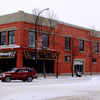Lethbridge - The Great Depression

The general boom experienced by most Albertans, including citizens of Lethbridge, after the First World War sent prices soaring and wages rising. The economic turnaround was a welcome relief for the city of Lethbridge who, like other communities, were severely impacted by The Great War. Lethbridge established a number of artillery units in the city and even formed a home guard whose sole purpose was to protect the High Level Bridge. Roughly 20% of the city's population enlisted leaving thousands dead and many more wounded. Those who stayed behind supported the motto of "patriotism and production", rationing, recycling, and contributing to the war effort by any means possible.
The 1920s was an era of growth and prosperity. Cars soon lined the paved streets of downtown Lethbridge. Stores competed against each other for local business giving the consumer ample choices. Citizens of Lethbridge reveled in the prospect of attending various forms of entertainment. By 1920, the city featured three theatres catering to the diverse tastes of the community. The Capitol Theatre, with its elegant gold trim, satin curtains, and reserved seating, opened in 1929 and was enjoyed by much of Lethbridge's upper class. For those who could afford to play, golfing became a popular past time. Land was sold to the Hudson's Bay Athletic Club who soon opened the Henderson Lake Golf Club. The development of trails (primarily dirt roads) connecting Lethbridge with other communities across the south brought increased traffic and business to the area.
Religion and education were the cornerstones of Lethbridge's development. By 1925, the city supported 12 different congregations sealing its reputation as the Bible Belt of Canada. Both the Public and catholic School Boards continued to open new schools and renovate existing ones in response to Lethbridge's growing population. And by 1929, Lethbridge developers continued to make strides in establishing the city as a principle distribution and shopping centre.

The Stock Market crash of October 1929 precipitated the Great Depression although there had been several indicators prior suggesting an economic collapse. The Great Depression exposed Lethbridge's economic vulnerability marked most notably by a steep decrease in market prices. In fact, deflation characterized much of Lethbridge's economic environment during the early 1930s. For instance, wheat, the source of much of Lethbridge's wealth, earned $60 million in 1928 compared to just $9 million in 1933.
People were unable to find steady work, particularly coal miners, the vast majority of Lethbridge's unemployed. By 1939, the coal industry had declined to the point whereby coal miners could only work 25% of the time and production was at an all-time low. Perpetuating the downfall of Lethbridge's famous resource was a high tariff placed by The United States government on coal imported from Canada. Because of these economic conditions, Lethbridge's tax arrears stood at over $400,000 and many citizens lost their property. By 1937, 8,000 town lots had been reverted back to the city.
In spite of the difficult conditions, Lethbridge's real estate market surged forward at the beginning of the decade. Building permits nearly reached the million dollar mark in 1930, the best year since the First World War. A $75,000 addition was made to the Galt Hospital, establishing the health care centre as an efficient 100-bed facility. That same year, city officials announced the construction of the $300,000 St. Michael's Hospital.
Meanwhile, eighty residences were built temporarily alleviating the housing shortage identified by the local Board of Trade. Another significant building project of 1930 was the municipal airport, with a $20,000 hangar, proper lighting, fencing, and several runways. By the late 1930s, the Lethbridge Municipal Airport moved from its northside location to 730 acres of land south of the city, complete with $150,000 in upgrades.
In 1931, members of Lethbridge's real estate industry met with the Board of Trade and formed the Lethbridge and District Development Association to promote the use of irrigation in southern Alberta and to attract more industry to the region. Food processing was one such industry that found success in southern Alberta. The Taber Canning Company established a plant in 1934, shipping carloads of corn, beans, and peas to various points. O'Loane, Kiely & Company built a seed and processing plant in Lethbridge handling peas and beans. Ellison Milling, an established and successful enterprise, continued to purchase grain locally and manufacture flour for sale. Lethbridge's industrial sector benefited from increased trade with Southern Alberta, because of the development of a highway to Waterton via Cardston. Industrial site development in the 1930s was limited to the agricultural industry and included a $1 million grain elevator funded by the provincial government.
References
Johnston, Alex and den Otter, Andy A. Lethbridge: A Centennial History. Lethbridge: City of Lethbridge, 1991.



